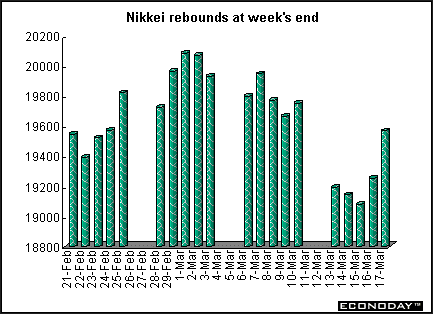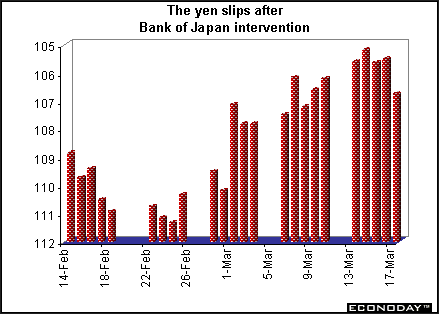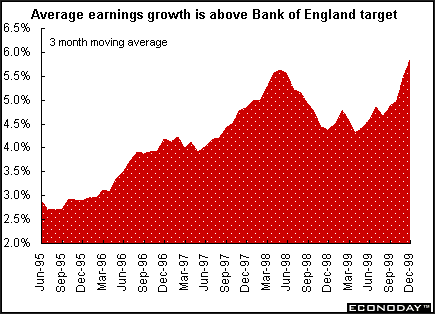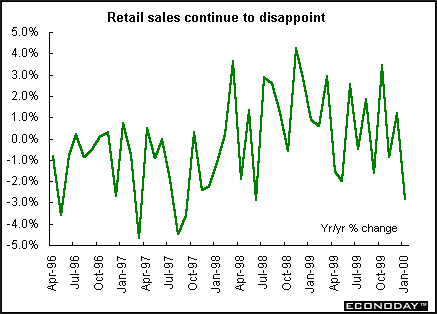| Previous Articles |
|
The equity markets gave us another volatility lesson last week. After plunging at the beginning of the week, the markets tried to recoup their losses in one day. Fickle investors rotated to old economy stocks from the new to the benefit of blue chips, while Technology, Media and Telecommunications (TMT) shares fell out of favor. Not surprisingly, there were no new highs last week. Overall, the overseas markets followed the U.S. markets in both directions. The markets are on alert
for Tuesday's Federal Reserve Open Market Committee meeting. The FOMC
is expected to lift U.S. interest rates 25 basis points to 6 percent.
Probably, the move is priced into the market already, although a 50
basis point increase would not be taken well.
Rotation
the highlight last week in Europe and Britain The two tier nature of Europe's stock markets was thrown sharply into focus as investors followed their U.S. counterparts and dumped highly rated technology stocks in favor of traditional blue chips. Just as the Dow Jones industrial average roared ahead while the technology laden Nasdaq dropped, Europe's large-cap indices surged at week's end at the expense of rival barometers skewed towards the new economy.
Investors who rediscovered old economy stocks such as airlines, banks and manufacturers drove the Dow's record breaking gains on Wednesday and Thursday. After three months of suffering for old-line shares, investors began to shift money into these stocks to the detriment of computers and software, biotechnology, Internet and telecommunications. One analyst described it as an awakening to the fact that the old stocks weren't dead. But the pain being taken by the new economy stocks was in sharp contrast to the revitalization in recently unfashionable areas of the market. For example, the FTSE 100 was pummeled on Friday when many of the new economy stocks which sank on Wednesday and Thursday staged a comeback while the old economy shares were the victims of profit taking. Friday's extreme volatility was partly caused by the simultaneous expirations in mid-morning of the March FTSE futures contract and index options. The FTSE 100 ended the week down 11 points or 0.16 percent at 6558. Neither the Frankfurt Dax nor the Paris CAC were able to recover their sharp losses from the earlier part of the week. The DAX lost 265 points or 3.32 percent on the week to close at 7710.92. The Paris CAC was buffeted by major swings to close down 206 points or 3.16 percent to close at 6304.28. Both markets took the European Central Bank's 25 basis point increase in stride. Asia The Australian All Ordinaries index was the only major Asian index to end the week on a positive note and just barely. It closed at 3203, up 3.9 points or 0.12 percent on the week. However, trading was not as benign on the Hong Kong Hang Seng which was down for a four day total of 1,472 points only to recover about half or 724 points on Friday. The Hang Seng ended the week down 4.2 percent at 17,083. The graph below shows the Hang Seng's bad week.
The Nikkei followed the pattern of other markets ending down on the week. It too recouped the first part of the week's losses with large gains on Thursday and Friday in response to the soaring Dow. However the Nikkei closed down 0.93 percent or 184 points to end the week at 19,750.4. The graph below illustrates the index's gyrations.
The Nikkei, prompted by heavy profit taking in Japanese technology, fell 2.84 percent on Monday. Institutional investors were eager to book gains in technology and Internet stocks before the March 31st year end. But the 1.4 percent drop in fourth quarter gross domestic product discouraged investors. The data raised doubts about Japan's efforts to overcome its worst economic slump in decades. The Nikkei is closed Monday for vernal equinox day, a national holiday. Currencies Japanese gross domestic product was released Monday and indicated that the economy was once again in recession. The yen climbed to a six week high against the dollar however, because market players focused on the capital spending increase rather than on the overall drop in economic growth. Corporate business investment climbed 4.6 percent, the biggest increase in nearly five years, and bolstered investor optimism on Japan's economic growth prospects.
On Wednesday, the Bank of Japan intervened in the currency markets to force the yen lower for the second time this month. A stronger yen could curb Japan's economic recovery by making exports less competitive in price and eroding the value of Japanese profits abroad. But the yen's decline was limited as exporters and other companies continued to sell dollars to bring funds home. By Friday, the yen began to slide on expectations that capital repatriation for the financial year end was near completion. Recent yen strength is expected to wane. Central
banks meet and report
The ECB left the markets in little doubt that further increases will follow shortly. Although the exact timing of the move took the markets by surprise it was the first time the ECB has moved rates without using its scheduled monthly news conference to explain its actions the Bank had made it clear that another increase was imminent. The ECB's action, however, only boosted the euro slightly, because it was overshadowed by a possible U.S. interest rate increase this week. Analysts said that the ECB may have been motivated by expectations that the Federal Reserve will raise U.S. rates and wanted to be seen acting unilaterally rather than following the Fed's lead. The Swiss National Bank left the target range of the 3 month Libor at 1.75 percent to 2.75 percent despite the European Central Bank's move to raise rates by 25 basis points. In December, the SNB switched its policy strategy from targeting money supply growth to targeting money market rates. It set an initial target range for the 3-month Libor of 1.25 percent to 2.25 percent and subsequently raised it on February 3rd by 50 basis points after the ECB hiked rates by 25 basis points on the same day. The Central Bank of Denmark raised its 14 day lending rate to 3.85 percent from 3.60 percent and its discount rate by 25 basis points to 3.50 percent from 3.25 percent. The Danish central bank last raised rates on February 3rd, when they raised the 14 day lending rate 30 basis points and the discount rate 25 basis points. Those rate moves also followed the ECB's 25 basis point rate increase earlier that day. The Norges Bank (Norway's central bank) left its official interest rates. The sight deposit rate remains at 5.50 percent while the overnight lending rate stays at 7.50 percent. The last adjustment by the Norges Bank to key interest rates involved a 50 basis point reduction in September. However, given indications that both Norwegian growth and inflation will be higher than expected this year and next, the Bank said it is more likely that its next rate move will be an increase rather than a reduction. Although not a central bank, the Hong Kong Association of Banks Friday left its key deposit rates unchanged at 4 percent. Commercial banks in Hong Kong generally follow any HKAB move with changes in their own deposit and lending rates. The Bank of Japan released minutes of its February 10th Monetary Policy Board meeting. Committee members ruled out an inflation target that would be used to reinflate the economy. However, they thought it worthwhile to look at a target if it would help the Bank become more transparent and underline its commitment to price stability. Members were of the opinion that private consumption data might not be accurately reflecting the true picture of the economy, since consumer spending habits have been changing. The minutes repeated the overall assessment that the economy has recently started to improve. Indicator Scoreboard
The February claimant unemployment rate remained at 4.0 percent, the lowest since January 1980. The unemployment rate on the International Labor Organization measure, which includes people looking for work but not eligible for benefits, was also unchanged, at 5.9 percent in the three months to January. January average earnings rose 0.4 percent and 5.9 percent in the year to January. The sharp increase is largely a result of financial service sector bonuses and one time millennium payments. Average earnings in private firms rose by 6.3 percent in the year to January, compared with 4 percent in the public sector.
February seasonally adjusted input prices rose 3.1 percent and 14.5 percent when compared to last year. The jump was mostly due to crude oil prices, which were up an unadjusted 11.3 percent on the month and 172.0 percent on the year. This contributed some 1.6 points to the input price index in February. February non-seasonally adjusted output prices inched up 0.1 percent on the month taking the annual rate down to 2.3 percent from 2.4 percent last month. EMU The deficit to gross domestic product ratio fell to 1.2 percent in 1999 from 2.0 percent a year earlier. Aggregate government debt fell to 72.2 percent of GDP from 73.4 percent in 1998. Spain January unadjusted retail sales fell 16.94 percent but rose 10.79 percent on the year. Specialized retail sales were down 25.71 percent in January. February consumer price index rose 0.1 percent and 3.0 percent when compared with last year. Higher energy prices were offset by lower food prices. Energy product prices rose 1.8 percent on the month and 14.7 percent on the year, while fuel prices were up 2.5 percent on the month and 21.2 percent on the year. Germany February wholesale prices excluding combustibles and motor fuels wholesale prices jumped 0.9 percent and 2.4 percent when compared with last year. Combustibles (crude oil, gas and coal) and motor fuels were up 3.5 percent on the month and 49.1 percent on the year. January Import prices rose 0.8 percent on the month and 9.2 percent when compared with last year. Bundesbank data for January total and seasonally and calendar adjusted real retail sales including sales at auto dealerships and petrol stations fell 4.3 percent in January and were down 3.7 percent when compared to last year. These data are even more disappointing than the figures released earlier by the Statistics Office, which showed a 2.7 percent decline on the year excluding automobile dealerships and gasoline station sales.
Asia
February corporate bankruptcies rose 51 percent when compared to last year, marking the largest increase in eight years. Debts left behind by insolvent companies rose for the first time in seven months. The amount of total liabilities left behind exceeded 1 trillion yen also for the first time in seven months. February's debt figure was double what it was in January. Of the total, 75 percent were recession induced. Hong Kong January retail sales value surged 12 percent when compared with last year, as consumers went on a spending spree ahead of the Lunar New Year holiday. This was the first increase in the value of Hong Kong's retail sales when compared with a year earlier since October 1997. The figures were affected by the timing of the Lunar New Year festival, which fell in early February this year. However, the increase was across the board and pointed to a further distinct rise in consumer demand. Australia Fourth quarter gross domestic product grew 1.0 percent and jumped 4.3 percent when compared with last year. GDP growth continues to be higher than trend. This was the eleventh straight quarter of over four percent growth.
Americas
January manufacturers' orders slipped 2.1 percent after a strong 4.7 percent jump in December. Manufacturers' shipments climbed 1.1 percent led by the aircraft and parts, wood, and refined petroleum and coal industries. Manufacturers' shipments increased in 14 of the 22 major groups, representing 67.9 percent of the total value of shipments. Manufacturers' backlog of unfilled orders decreased 1.0. The decline was mainly attributable to the setback in the transportation equipment industry. Manufacturers' inventories rose 0.7 percent. BOTTOM
LINE Looking
Ahead: March 20 to March 24, 2000
|
||||||||||||||||||||||||||||||||||||||||||||||||||||||||||||||||||||||||||||||||||||||||||||||||||||||||||||||||||||||||||||||||||||||||||||||||||||||||||||||||||||||||||||||||||||||||||










